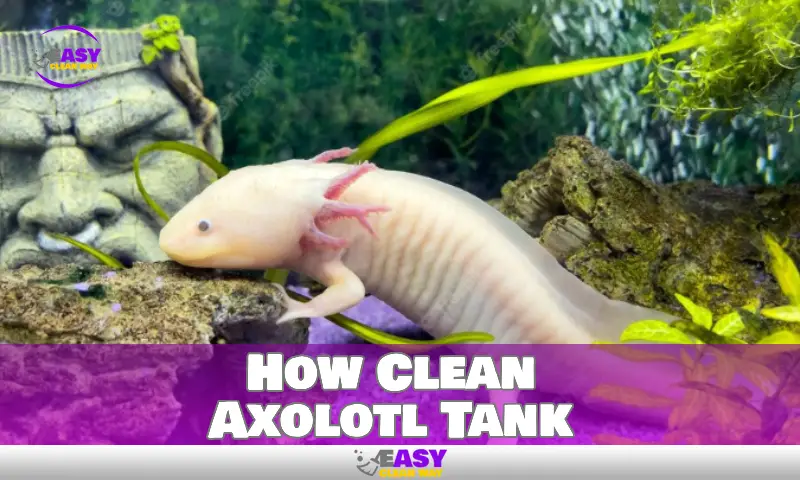To clean an axolotl tank, remove the axolotl and transfer it to a temporary container. Drain the water from the tank, removing any debris or waste.
Scrub the tank walls and decorations with a soft brush or sponge, using warm water without soap. Rinse thoroughly before refilling the tank with dechlorinated water. The cleanliness of an axolotl tank is essential for the health and well-being of these aquatic creatures.
Regular tank maintenance helps prevent the buildup of harmful bacteria and maintains water quality. We will discuss the steps involved in cleaning an axolotl tank to ensure a safe and comfortable environment for your pet axolotl. Read on to learn how to maintain a clean and healthy axolotl tank.
Importance of A Clean Axolotl Tank
A clean axolotl tank is vital for the overall well-being of your pet. Neglecting proper tank maintenance can lead to various health issues for your axolotl. Dirty water can harbor harmful bacteria and toxins that can compromise their immune systems.
These pollutants can irritate their delicate skin and gills, causing respiratory problems and skin infections. Additionally, a dirty tank can result in poor water quality, affecting oxygen levels and pH balance, which are essential for your axolotl’s survival. Regular cleaning and filtration are necessary to remove uneaten food, waste, and debris, ensuring a clean and healthy environment for your axolotl.
By maintaining a clean tank, you can promote the overall health and vitality of your axolotl, allowing them to thrive in their aquatic habitat.
Choosing The Right Tank Setup

Selecting the right tank setup for your axolotls involves considering several crucial factors. One such factor is the proper tank size and dimensions necessary for these unique creatures. Axolotls require a tank with adequate space to swim and move around comfortably.
Additionally, you should also take into account the options available for tank materials, each with its own advantages and disadvantages. Glass tanks offer visibility but are prone to breaking, while acrylic tanks are more durable but may scratch easily. These considerations are important when choosing the right tank for your axolotls to ensure their well-being and create a clean and conducive environment for them to thrive.
Setting Up A Filtration System
Setting up a filtration system for your axolotl tank is crucial to maintaining a clean and healthy environment for your pet. There are different types of filtration systems available, so it’s important to understand their differences. When selecting the ideal filtration system, consider factors such as tank size and the number of axolotls you have.
Once you’ve chosen the right system, proper installation is key. Ensure that all components are securely in place and that the system is functioning correctly. Regular maintenance is essential to keep the filtration system running smoothly. Regularly clean the filter media and replace it when necessary.
Remember to monitor water quality regularly to ensure the filtration system is working effectively. With a properly functioning filtration system, you can provide your axolotls with a clean and safe habitat to thrive in.
Selection And Placement Of Substrate
When it comes to creating a clean and healthy environment for your axolotl, the selection and placement of substrate are crucial. The substrate plays a vital role in the overall well-being of these fascinating creatures. There are different types of substrate suitable for axolotl tanks, such as sand, gravel, or bare bottoms.
When selecting a substrate, it is essential to consider its size, texture, and cleanliness. The substrate should be fine enough to prevent any potential injuries to the axolotl’s delicate skin. Proper placement of the substrate is equally important. It should cover the entire tank bottom uniformly, creating a comfortable and natural habitat for your axolotl.
Avoid leaving any bare spots, as they can cause stress for your pet. By following these guidelines, you can ensure that your axolotl tank remains clean and that your axolotls stay healthy.
Water Quality And Parameters
Maintaining optimal water quality for axolotls is crucial for their health and well-being. Monitoring and adjusting water parameters effectively ensures a clean and suitable environment. Regularly testing the water using reliable kits is a significant part of tank maintenance. It helps to determine important factors like pH levels, ammonia levels, nitrate levels, and nitrite levels.
Understanding these parameters allows for necessary adjustments to keep the tank clean and safe for the axolotls. By ensuring the water quality is optimal, axolotls can thrive and exhibit their natural behavior. It is essential to regularly monitor and maintain the water conditions, providing a healthy and comfortable habitat for these unique creatures.
Keeping the water clean and balanced is key to promoting their overall longevity and vitality. Therefore, proper water quality management is vital to ensuring the well-being of axolotls.
Regular Water Changes
Regular water changes are essential for maintaining a clean axolotl tank. By establishing a schedule and frequency for water changes, you can ensure the cleanliness and health of your aquatic pets. Performing a successful water change without stressing your axolotl is crucial.
Here are some steps to help you achieve this. First, start by preparing the new water, making sure it is free from any harmful chemicals and at the right temperature. Next, slowly add the new water to the tank, aiming for a gradual change rather than a drastic one.
Make sure to remove any uneaten food, waste, or debris from the tank during the water change process. Finally, monitor the water parameters regularly to ensure they are within the appropriate range for axolotls. Following these guidelines will help you maintain a clean and healthy environment for your axolotl friends.
Tank Decorations And Maintenance
Selecting appropriate decorations for an axolotl tank is crucial for maintaining a clean and healthy environment. Cleaning these decorations effectively without using harmful chemicals is essential. To prevent the growth of algae, regular maintenance is necessary. Simple maintenance tips include regularly scrubbing the decorations with a soft brush, rinsing them thoroughly with water, and letting them dry completely before putting them back in the tank.
Additionally, it is important to avoid using soap or detergent, as residue can be harmful to axolotls. Maintaining a clean tank and decorations promotes the overall well-being of axolotls, ensuring they thrive in their aquatic habitat. So, make sure to choose decorations wisely and establish a regular cleaning routine to provide the best possible environment for your axolotl.
Feeding Techniques To Minimize Tank Pollution
Feeding axolotls properly is crucial to maintaining a clean tank and minimizing pollution. It is important to provide them with a suitable and nutritious diet that meets their nutritional needs. Avoid overfeeding, as this can lead to excessive waste in the tank.
Feed your axolotls small portions of food at a time and remove any uneaten food after a few minutes. Opt for high-quality pellets or live foods like worms and brine shrimp. Avoid feeding them human food or insects that may contain pesticides.
By following these proper feeding practices, you can ensure that your axolotl tank remains clean and that the water quality is not compromised.
Handling Waste And Detritus
To effectively remove waste and debris from your axolotl tank, it’s essential to use appropriate cleaning tools that won’t disturb your axolotl. By following these steps, you can prevent waste accumulation and promote a clean environment for your aquatic companion.
Regularly use a siphon to remove debris from the substrate, gently hovering the tool above to avoid disturbing your axolotl. Invest in a fine-mesh net to skim the surface and remove any floating waste. Additionally, consider using a filter with appropriate filtration media to efficiently remove solid waste particles.
Be diligent in monitoring your axolotl’s feeding habits and adjust the amount of food accordingly to minimize waste. Implementing regular water changes and maintaining proper water parameters will also contribute to a cleaner tank environment. By implementing these strategies, you can ensure a clean and healthy habitat for your axolotl.
Preventing And Treating Diseases
Detecting early signs of illness is crucial to maintaining the health of the axolotls in your tank. By closely observing their behavior and appearance, you can identify any potential diseases. Preventive measures, such as regular tank cleanings and maintaining optimal water conditions, play a vital role in avoiding the onset of illnesses.
In the event that your axolotl does fall ill, it’s important to seek proper medication and treatment options. Some common diseases that can affect axolotls due to poor tank conditions include fungal infections, bacterial infections, and parasitic infestations. Prompt action and appropriate treatment can help your axolotl recover and thrive in a clean and healthy environment.
Remember to consult a veterinarian for the best course of action if you notice any signs of illness in your axolotl.
Maintaining Optimal Temperature And Lighting
Maintaining the ideal temperature and lighting conditions is crucial for a clean axolotl tank. By carefully choosing suitable heating and lighting options, you can ensure a comfortable environment for your axolotls. Monitoring the temperature regularly is essential to keeping it at an optimal level and promoting their well-being.
Similarly, providing the right amount and type of lighting helps support their natural behavior and overall health. Axolotls are sensitive to changes in temperature and lighting, so it’s important to maintain a consistent and suitable environment for them. By paying attention to these factors, you can create a clean and comfortable habitat for your axolotls, allowing them to thrive and stay healthy.
Regular Tank Inspections And Troubleshooting

Regular tank inspections play a pivotal role in maintaining a clean and healthy axolotl tank. By conducting these inspections on a consistent basis, potential issues can be detected early on, preventing them from becoming more serious problems. Some common tank problems include water quality issues, temperature fluctuations, and equipment malfunctions.
Troubleshooting these problems promptly is crucial for the well-being of your axolotl. To maintain a long-term clean and healthy tank, it is important to keep up with routine maintenance tasks such as regular water changes, cleaning the filter, and monitoring water parameters.
Additionally, ensuring adequate lighting conditions and providing proper nutrition are essential for the overall health of your axolotl. By following these steps and staying vigilant with tank inspections, you can provide a suitable environment for your axolotl to thrive.
FAQ
How Often Should I Clean My Axolotl Tank?
It is recommended to clean your axolotl tank once a week to maintain a healthy and clean environment for your pet.
What Supplies Do I Need To Clean An Axolotl Tank?
To clean an axolotl tank, you will need a siphon vacuum, a clean bucket, a soft sponge or cloth, and dechlorinated water.
How Do I Clean The Gravel In My Axolotl Tank?
To clean the gravel in your axolotl tank, use the siphon vacuum to remove any uneaten food or waste, gently vacuuming the surface of the gravel.
How Do I Clean The Axolotl Tank Filter?
To clean the axolotl tank filter, turn off the filter and remove the cartridge or filter media. Rinse it in dechlorinated water to remove any debris, then reassemble and restart the filter.
Conclusion
Cleaning your axolotl tank is an essential part of pet ownership. Regular maintenance ensures a healthy and comfortable environment for these fascinating creatures. By following simple steps, you can keep your axolotl tank clean and maintain the well-being of your pets.
Start by removing any uneaten food, waste, or debris from the tank using a siphon or turkey baster. Next, perform partial water changes on a weekly basis to maintain water quality. Use a water conditioner to remove chlorine or chloramines and maintain proper PH levels.
Clean the tank walls and decorations with an aquarium-safe scrub brush or sponge to remove algae buildup. Finally, monitor the water temperature, filtration system, and other equipment regularly to ensure everything is functioning properly. Keep in mind that a clean and well-maintained axolotl tank will not only benefit your pets but also enhance the aesthetic appeal of your living space.
With these guidelines, you can confidently provide a clean and comfortable habitat for your axolotls, ensuring their health and happiness.
Hey there! I’m Alton Smith, your Clean Expert blogger. I’m on a quest to help you conquer chaos and embrace the joys of a tidy life.





